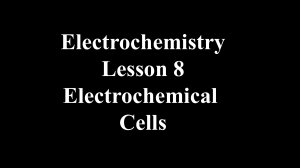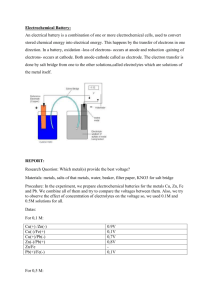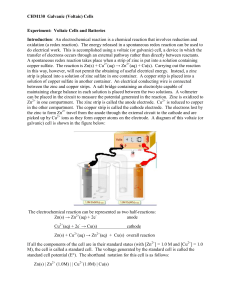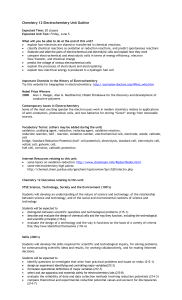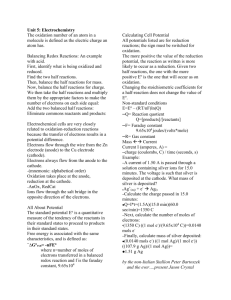Slides 19
advertisement
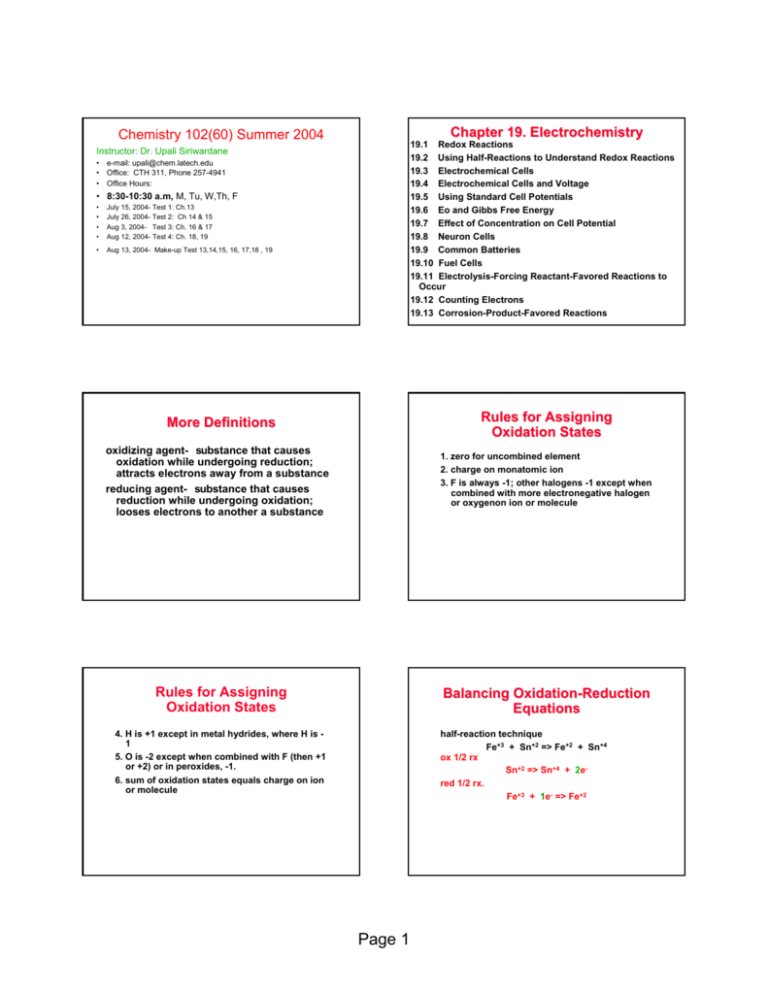
Chapter 19. Electrochemistry Chemistry 102(60) Summer 2004 19.1 Redox Reactions 19.2 Using Half-Reactions to Understand Redox Reactions 19.3 Electrochemical Cells 19.4 Electrochemical Cells and Voltage 19.5 Using Standard Cell Potentials 19.6 Eo and Gibbs Free Energy 19.7 Effect of Concentration on Cell Potential 19.8 Neuron Cells 19.9 Common Batteries 19.10 Fuel Cells 19.11 Electrolysis-Forcing Reactant-Favored Reactions to Occur 19.12 Counting Electrons 19.13 Corrosion-Product-Favored Reactions Instructor: Dr. Upali Siriwardane • e-mail: upali@chem.latech.edu • Office: CTH 311, Phone 257-4941 • Office Hours: • 8:30-10:30 a.m, M, Tu, W,Th, F • • • • July 15, 2004- Test 1: Ch.13 July 26, 2004- Test 2: Ch 14 & 15 Aug 3, 2004- Test 3: Ch. 16 & 17 Aug 12, 2004- Test 4: Ch. 18, 19 • Aug 13, 2004- Make-up Test 13,14,15, 16, 17,18 , 19 Rules for Assigning Oxidation States More Definitions oxidizing agent- substance that causes oxidation while undergoing reduction; attracts electrons away from a substance reducing agent- substance that causes reduction while undergoing oxidation; looses electrons to another a substance 1. zero for uncombined element 2. charge on monatomic ion 3. F is always -1; other halogens -1 except when combined with more electronegative halogen or oxygenon ion or molecule Rules for Assigning Oxidation States Balancing OxidationOxidation-Reduction Equations 4. H is +1 except in metal hydrides, where H is 1 5. O is -2 except when combined with F (then +1 or +2) or in peroxides, -1. 6. sum of oxidation states equals charge on ion or molecule half-reaction technique Fe+3 + Sn+2 => Fe+2 + Sn+4 ox 1/2 rx Sn+2 => Sn+4 + 2ered 1/2 rx. Fe+3 + 1e- => Fe+2 Page 1 Balancing OxidationOxidation-Reduction Equations Balancing OxidationOxidation-Reduction Equations half-reaction technique Fe+3 + Sn+2 => Fe+2 + Sn+4 ox 1/2 rx Sn+2 => Sn+4 + 2ered 1/2 rx. 1( ) Fe+3 + 1e- => Fe+2 half-reaction technique Fe+2 + MnO4- + H+ => Mn+2 + Fe+3 + H2O 2( ox 1/2 rx Fe+2 => Fe+3 + 1ered 1/2 rx MnO4- + 8H+ + 5e- => Mn+2 + 4H2O ) Sn+2 + 2Fe+3 => Sn+4 + 2Fe+2 Balancing OxidationOxidation-Reduction Equations Balancing Redox Reactions: acid solution H+ => H2O base solution OH- => H2O half-reaction technique Fe+2 + MnO4- + H+ => Mn+2 + Fe+3 + H2O ox 1/2 rx 5(Fe+2 => Fe+3 + 1e-) or H2O => H+ or H2O => OH- red 1/2 rx 1 (MnO4- + 8H+ + 5e- => Mn+2 + 4H2O) 5Fe+2 + MnO4- + 8H+ => Mn+2 + 5Fe+3 + 4H2O Electrochemical Cells Daniel's Cell • harnessed chemical reaction which produces an electric current • called Voltaic Cells or Batteries • anode - electrode where oxidation occurs • cathode - electrode where reduction occurs • Cell Potential - the potential difference, in volts, between the electrodes of an electrochemical cell 1.10 v Zinc anode Zn+2 Zn+2 Cu+2 Cu+2 Zn+2 Zn+2 Cu+2 Cu+2 Copper cathode Page 2 • battery for telegraph • copper electrode dipped into a solution of copper(II) sulfate • zinc electrode dipped into a solution of zinc sulfate Daniel's Cell Simple Electrochemical Cell Zn(s) + Cu+2(aq) => Zn+2(aq) + Cu(s) oxidation half reaction anodeZn(s) => Zn+2(aq) + 2 ereduction half reaction cathode Cu+2(aq) + 2 e- => Cu(s) Apple Battery Electrochemical Terminology Copper and zinc metal strips as electrodes in an apple to supply the electrolytes. Photo by Mike Condren Standard Cell Potential Electrical Work • the potential difference, in volts, between the electrodes of an electrochemical cell when the all concentrations of all solutes is 1 molar, all the partial pressures of any gases are 1 atm, and the temperature at 25oC • direction of Oxidation-Reduction Reactions • positive value indicates a spontaneous reaction electrical work = charge × potential energy difference coulombs = amperes × seconds 1 volt = 1 joule/coulomb thus 1 joule = 1 volt × 1 coulomb Page 3 Standard Hydrogen Electrode Zn vs. Hydrogen Electrode • consists of a platinum electrode covered with a fine powder of platinum around which H2(g) is bubbled. Its potential is defined as zero volts. H2(g) = 2 H+(aq) + 2 ereversible reaction Cu vs. Hydrogen Electrode Cell Diagram • the shorthand representation of an electrochemical cell showing the two halfcells connected by a salt bridge or porous barrier, such as: Zn(s)/ZnSO4(aq)//CuSO4(aq)/Cu(s) anode cathode Redox Reaction Standard Reduction Potentials • the reduction half reaction is the half reaction with the more positive reduction potential • the half reaction with the lower reduction potential is reverse and the sign of the potential is changed • the cell potential is the sum of the half reaction potentials Page 4 Metal Displacement Reactions Dental Voltaic Cell • solid of more reactive metals will displace ions of a less reactive metal from solution • relative reactivity based on potentials of half reactions • metals with very different potentials react most vigorously Cell Potentials & ∆G Cell Potentials, ∆G, and Q ∆G = -nFE or where n× ∆Go = -nFEo number of electrons involved in reaction F× Faraday's constant, 1 mole e- = 96,500 coulombs thus ∆G = ∆Go + RT ln Q Cell Potentials, ∆G = -nFE or ∆Go = -nFEo ∆G = ∆Go + RT ln Q -nFE = -nFEo + RT ln Q or E = Eo - (RT/nF) ln Q Effect of Concentration on Cell Voltage: ∆G, and K The Nernst Equation Ecell = Eocell - (RT/nF)ln Q Ecell = Eocell - (0.0592/n)log Q where Q × reaction quotient E = Eo - (RT/nF) ln Q at equilibrium 0 = Eo - (RT/nF) ln Keq and (nFEo)/(RT) = ln Keq thus Keq = e(nFE /RT) Q = [products]/[reactants] Page 5 Relationships Linking: ∆Go, Ecello, and Ko EXAMPLE: What is the cell potential for the Daniel's cell when the [Zn+2] = 10 [Cu+2]? Ecell = Eocell - (0.0257/n)ln Q Q = ([Zn+2]/[Cu+2 ] = (10 [Cu+2])/[Cu+2]) = 10 Eo = (0.34 V)Cu couple + (-(-0.76 V)Zn couple n = 2, 2 electron change Ecell = (1.10 - (0.0257/2)ln 10) V Ecell = (1.10 - (0.0257/2)2.303) V Ecell = (1.10 - 0.0296) V = 1.07 V Ionic Concentrations and Mammalian Neuron Cell pH Meter Eglass electrode = 0.0592pH + constant Batteries Equilibrium Potential for K+ ions Across a Neuronal Cell Membrane Primary Cells non-reversible, non-rechargeable electrochemical cell "dry" cell & alkaline cell 1.5 v/cell mercury cell 1.34 v/cell fuel cell 1.23v/cell Page 6 Batteries “Flash Light” Batteries Secondary Cells reversible, rechargeable electrochemical cell lead-acid (automobile battery) 2 v/cell NiCad 1.25 v/cell Primary Cells "Dry" Cell Zn(s) + 2 MnO2(s) + 2 NH4+ × Zn+2(aq) + 2 MnO(OH)(s) + 2 NH3 Alkaline Cell Zn(s) + 2 MnO2(s) × ZnO(s) + Mn2O3(s) Mercury Battery Leclanche “Dry” Cell Primary Cells Zn(s) + HgO(s) × ZnO(aq) + Hg(l) Lead-Acid (Automobile Battery) Secondary Cell LeadLead-Acid (Automobile Battery) charging battery requires electricity Pb(s) + PbO2(s) + 2 H2SO4 2 PbSO4(s) + 2 H2O discharging battery requires electricity 2 v/cell thus 12 volt battery = 6-2 volt cells Page 7 Lithium Battery NickelNickel-Cadmium (Ni(Ni-Cad) Anode reaction Li(s) (in polymer) => Li+ (in polymer) + eCathode reaction Li+(in CoO2) + e- => LiCoO2 Overall Li(s) + CoO2(s) => LiCoO2(s) Ecell = 3.4 volt Secondary Cell Cd(s) + 2 Ni(OH)3(s) Cd(OH)2(s) + Ni(OH)2(s) Electrolysis Fuel Cells • non-spontaneous reaction is caused by the passage of an electric current through a solution Quantitative Aspects of Electrolysis 1 coulomb = 1 amp sec 1 mole e- = 96,500 coulombs anode 2( H2(g) + 2 OH-(aq) => 2 H2O(l) + 2 e-) cathode O2(g) + 2 H2O(l) + 4 e- => 4 OH-(aq) Electrolysis of Sodium chloride Hall Process aluminum oxide partially breaks into ions in molten cryolite, Na3AlF6 Al+3 + 3e- => Al(l) molten NaCl => liquid sodium and chlorine gas aqueous NaCl => caustic soda (sodium hydroxide) and chlorine gas cathode 2O-2(melt) + C(s) => CO2(g) anode At the anode, graphite is consumed, and carbon dioxide is formed. At the cathode, liquid aluminum is formed. Page 8 Electrolytic Refining of Copper EXAMPLE: How many grams of chromium can be electroplated from a Cr+6 solution in 45 minutes at a 25 amp current? Cu(s) + Cu+2(aq) => Cu+2(aq) + Cu(s) impure pure anode cathode #g Cr = impurities: anode mud; Ag, Au, Pb (45 min) (60 sec) (1 C) (25 amp) (1 min) (1 amp sec) (52 g Cr) (1 mol e-) (96,500 C) (6 mole e- ) = 58 g Cr Corroding Iron Nails Corrosion O2(g) + 4 H+(aq) + 4 e- => 2 H2O(l) Eo = 1.23 V Rusting Fe(s) ⌫ Fe+2(aq) + 2 eO2(g) + 4 H+(aq) + 4 e- => 2 H2O(l) Eo = 0.44 V Eo = 1.23 V 2 Fe(s) + O2(g) + 4 H+(aq) => 2 H2O(l) + Fe+2(aq) Preventing Corrosion Galvanized Iron painting sacrificial cathode galvanizing Page 9 Eo = 1.67 V TRANSFER TRANSFER REACTIONS REACTIONS ELECTROCHEMISTRY ELECTROCHEMISTRY Chapter Chapter 21 21 Atom transfer A- + HOH- -- >HA + OH- Electron transfer Cu(s) + 2 Ag+(aq) (aq)- -- >Cu2+(aq) + 2 Ag(s) Electric automobile Electron Electron Transfer Transfer Reactions Reactions Review Review of of Terminology Terminology for for Redox Redox Reactions Reactions • Electron transfer reactions are oxidation reduction or redox reactions. • Can generate electric current or be caused by imposing an electric current. •• OXIDATION— —loss of OXIDATION OXIDATION—loss of electron(s) electron(s) by by aa species; species; increase increase in in oxidation oxidation number. number. •• REDUCTION— —gain of REDUCTION REDUCTION—gain of electron(s); electron(s); decrease decrease in in oxidation oxidation number. number. •• OXIDIZING —electron acceptor; AGENT OXIDIZING AGENT— AGENT—electron acceptor; species species is is reduced. reduced. •• REDUCING —electron donor; AGENT REDUCING AGENT— AGENT—electron donor; species species is is oxidized. oxidized. • ELECTROCHEMISTRY. OXIDATION -REDUCTION OXIDATION-REDUCTION REACTIONS REACTIONS OXIDATION -REDUCTION OXIDATION-REDUCTION REACTIONS REACTIONS Direct Redox Reaction Oxidizing and reducing agents in direct contact. Cu2+(aq) + 2 Ag(s) Cu(s) + 2 Ag+(aq) (aq) Indirect Redox Reaction A battery functions by transferring electrons through an external wire from the reducing agent to the oxidizing agent. Page 10 Why Why Study Study Electrochemistry? Electrochemistry? Electrochemical Electrochemical Cells Cells • Batteries • Corrosion • Industrial production of chemicals such as Cl2, NaOH, NaOH, F2 and Al • Biological redox reactions • An apparatus that allows a redox reaction to occur by transferring electrons through an external connector. • Product favored reaction voltaic or galvanic cell (batteries) current is used to perform work • Reactant favored reaction electrolytic cell current used to cause chemical change. The heme group CHEMICAL CHEMICAL CHANGE CHANGE ELECTRIC ELECTRIC CURRENT CURRENT Zn Zn metal metal 2+ ions Cu Cu2+ ions Adding -reactions half Adding halfhalf-reactions Oxidation: Zn(s) Zn2+(aq) + 2e Cu(s) Reduction: Cu2+(aq) + 2e -------------------------------------------------------Cu2+(aq) + Zn(s) Zn2+(aq) + Cu(s) (already balanced) With With time, time, Cu Cu plates plates out out onto onto Zn Zn metal metal strip, strip, and and Zn Zn strip strip “disappears.” “disappears.” •Zn is oxidized and is the reducing agent Zn(s) Zn2+(aq) + 2e 2+ •Cu is reduced and is the oxidizing agent Cu2+(aq) + 2e Cu(s) •Separate the oxidizing and reducing agents : electron transfer occurs thru an external wire. •This is accomplished in a GALVANIC or VOLTAIC cell. wire -Oxidation -Anode (negative) Electron source •A group of such cells is called a battery. e le c t ro ns Zn Zn2+ ions salt bridge Cu Cu2+ ions -reduction -Cathode (positive) electron sink wire e le c t ro ns Zn Zn2+ ions salt bridge Salt Salt bridge bridge allows allows anions anions and and cations cations to to move move between between electrode electrode compartments. compartments. (This (This maintains maintains electrical electrical neutrality). neutrality). Cu Cu2+ ions Page 11 Electrons move from anode to cathode in the wire. Anions & cations move thru the salt bridge. Balancing Balancing Equations Equations Consider the reduction of Ag+ ions with copper metal. Electrochemical Cell Cu + Ag+ Balancing Balancing Equations Equations Step 1: Ox Red Step 2: Step 3: Ox Red Balancing Balancing Equations Equations Step 4: Multiply each half- reaction to balance electrons Reducing agent Cu Cu2+ + 2e + Oxidizing agent 2 Ag + 2 -e 2 Ag Step 5: Add half- reactions to give the overall equation. Cu + 2 Ag+ Cu2+ + 2Ag Divide the reaction into halfhalf-reactions Cu Cu2+ Ag+ -> Ag Balance each for mass. Already done in this case. Balance each halfhalf-reaction for charge by adding electrons. Cu Cu2+ + 2e2eAg+ + eAg The equation is now balanced for both charge and mass. Balancing Balancing Equations: Equations: Acidic Solution Acidic Solution Balance the following in acid solution— solution— VO2+ Step 1: Ox Red Step 2: mass. Ox Red Balancing Balancing Equations Equations Step 3: Ox Red Step 4: Ox Red 2-e + Zn VO2+ + Zn2+ Write the half- reactions Zn Zn2+ VO2+ VO2+ Balance each half- reaction for Zn Zn2+ + 2 H + VO2+ VO2+ Cu2+ + Ag Balance half- reactions for charge. Zn Zn2+ + 2e -e + 2 H+ + VO2+ VO2+ + H2O Multiply by an appropriate factor. Zn Zn2+ + 2e + 4 H+ + 2 VO2+ 2 VO2+ + 2 H2O Step 5: Add half- reactions Zn + 4 H+ + 2 VO2+ Zn2+ + 2 VO2+ + 2 H2O + H2O Add H2O on OO-deficient side and add H+ on other side for HH-balance. Page 12 CELL CELL POTENTIAL, POTENTIAL, E E Tips on Balancing Equations • Never add O2, O atoms, or O2- to balance oxygen. • Never add H2 or H atoms to balance hydrogen. • Be sure to write the correct charges on all the ions. • Check your work at the end to make sure mass and charge are balanced. Zn and Zn2+, anode Cu and Cu2+, cathode • Electrons are “driven” from anode to cathode by an electromotive force or emf. • Voltage = 1.10 V • at 25 °C C and when [Zn2+] and [Cu2+] = 1.0 M. • This is the STANDARD CELL POTENTIAL, Eo Calculating Calculating Cell Cell Voltage Voltage CELL CELL POTENTIAL, POTENTIAL, E E • Balanced half- reactions can be added together to get overall, balanced equation. • a quantitative measure of the tendency of reactants to proceed to products when all are at unit concentration (1.00M) 22II- - ---> ---> II22 ++ 2e2e+ 2e- ---> 2 OH- - + H 22HH2O 2O + 2e- ---> 2 OH + H22 --------------------------------------------------------------------------------------------------> I + 2 OH- - + H 22II- - ++ 22 HH2O 2O --> I22 + 2 OH + H22 • If we know Eo for each half- reaction, we could get Eo for net reaction. 2+ half Zn/Zn -- cceellll hooked Zn/Zn2+ half hooked to to aa SHE. SHE. EEoo for for the the cell cell == +0.76 +0.76 VV CELL CELL POTENTIALS, POTENTIALS, E Eoo • Can’t measure 1/2 reaction Eo directly. Therefore, measure it relative to a STANDARD HALF CELL, SHE. Volts Zn 22 H (aq 2e H++(aq, (aq,, 11 M) M) ++ 2e2e- - + Salt Bridge H ) atm H22(g, (g, 11 atm) atm) Zn2+ Eo = 0.0 V Zn Zn2+ + 2eOXIDATION ANODE Page 13 H+ 2 H+ + 2eH2 REDUCTION CATHODE H2 Volts Volts + - Zn Zn2+ Zn(s) Zn(s) + 2 Therefore, (aq) aq)- - Eo >Zn2+ Zn2+ for Zn - -- + H2(g) > Zn2+ Eo = +0.76 V (aq) - is aq) + 2e +0.76 V. V. H2 H+ Zn Zn2+ + 2eOXIDATION ANODE 2 H+ + 2eH2 REDUCTION CATHODE Overall reaction is reduction of H+ by Zn metal. H+ Salt Bridge H2 H+ Zn Zn2+ + 2eOXIDATION ANODE + - Zn Salt Bridge 2 H+ + 2eH2 REDUCTION CATHODE Overall reaction is reduction of H+ by Zn metal. Zn(s) Zn(s) + 2 H+ (aq) aq)- - >Zn2+ + H2(g) Therefore, Eo for Zn - -- > Zn2+ Eo = +0.76 V (aq) - is +0.76 V. aq) + 2e V. Zn is a (better) (poorer) reducing agent than H2. Better! 2+ and Cu/Cu Cu/Cu2+ and H H22/H /H++ Cell Cell 2+ and Cu/Cu Cu/Cu2+ and H H22/H /H++ Cell Cell Volts Cu - + Salt Bridge Cu 2+ Cu 2+ + 2eCu REDUCTION CATHODE Eo = +0.34 V Volts + Cu H2 H+ Salt Bridge Cu2+ H2 2 H + + 2eOXIDATION ANODE Cu2+ + 2eCu REDUCTION CATHODE Zn/Cu Zn/Cu Electrochemical Electrochemical Cell Cell H2 H+ H2 2 H+ + 2eOXIDATION ANODE Standard Standard Redox Redox Potentials, Potentials, E Eoo Zn(s) - -- > Zn2+(aq) + 2e Eo = +0.76 V 2+ - - -- >Cu(s) Eo = +0.34 V Cu (aq) + 2e --------------------------------------------------------------Cu2+(aq) + Zn(s)- -- >Zn2+(aq) + Cu(s) oxidizing ability of ion Eo = +1.10 V Eo (V) Cu2+ + 2e- Cu +0.34 2 H+ + 2e- H2 0.00 Zn2+ + 2e- Zn -0.76 reducing ability of element Page 14 • Any substance on the right will reduce any substance higher than it on the left. • Zn can reduce H+ and Cu2+. • H2 can reduce Cu2+ but not Zn2+ • Cu cannot reduce H+ or Zn2+. E Eoo for for aa Voltaic Voltaic Cell Cell E Eoo and and ∆ ∆G Goo Volts Cd Fe Salt Bridge Eo is related to ∆G Go, the free energy change for the reaction. Fe2+ Cd2+ ∆Go = - n F Eo From table data : • Fe is a better reducing agent than Cd • Cd2+ is a better oxidizing agent than Fe2+ Overall reaction Fe + Cd2+- -- >Cd + Fe2+ Eo = +0.04 V F = Faraday constant = 9.6485 x 104 J/V•mol n = number of moles of electrons Michael Faraday transferred 17911791-1867 E Eoo and and ∆ ∆G Goo ∆ Go Quantitative Quantitative Aspects Aspects of of Electrochemistry Electrochemistry Eo = -nF For a productproduct-favored reaction Reactants ----> ----> Products o ∆G < 0 and so Eo > 0 Eo is positive For a reactantreactant-favored reaction Reactants <---<---- Products o ∆G > 0 and so Eo < 0 Eo is negative Consider electrolysis of aqueous silver ion. Ag+ (aq) aq) + -e --- > Ag(s) 1 mol -e --- > 1 mol Ag If we could measure the moles of -e , we could know the quantity of Ag formed. But how to measure moles of -e ? Quantitative Quantitative Aspects Aspects of of Electrochemistry Electrochemistry Current = charge passing time I (amps) = Quantitative Quantitative Aspects Aspects of of Electrochemistry Electrochemistry I (amps) = 1.50 amps flow thru a Ag+(aq) (aq) solution for 15.0 min. What mass of Ag metal is deposited? Solution (a) Calc. charge Coulombs = amps x time = (1.5 amps)(15.0 amps)(15.0 min)(60 sec/min) = 1350 C coulombs seconds But how is charge related to moles of electrons? Charge on 1 mol of -e = (1.60 x 10-19 C/e - )(6.02 x 1023 -e /mol) = 96,500 coulombs seconds C/mol ee- = 1 Faraday Page 15 Quantitative Quantitative Aspects Aspects of of Electrochemistry Electrochemistry Quantitative Quantitative Aspects Aspects of of Electrochemistry Electrochemistry The anode reaction in a lead storage battery is Pb(s) Pb(s) + HSO4-(aq)- -- >PbSO4(s) + H+(aq) (aq) + 2e If a battery delivers 1.50 amp, and you have 454 g of Pb, Pb, how long will the battery last? coulombs I (amps) = seconds 1.50 amps flow thru a Ag+(aq) (aq) solution for 15.0 min. What mass of Ag metal is deposited? Solution (a) Charge = 1350 C (b) Calculate moles of e - used 1350 C • (c) 1 mol e = 0.0140 mol e 96, 500 C Calc. quantity of Ag 0.0140 mol e - • 1 mol Ag = 0.0140 mol Ag or 1.51 g Ag 1 mol e - Solution a) 454 g Pb = 2.19 mol Pb b) moles of -e = 4.38 c) Calculate charge 4.38 mol -e • 96,500 C/mol -e = 423,000 C Quantitative Quantitative Aspects Aspects of of Electrochemistry Electrochemistry Solution a) 454 g Pb = 2.19 mol Pb b) Calculate moles of e 2.19 mol Pb • a) b) c) d) 2 mol e = 4.38 mol e 1 mol Pb 454 g Pb = 2.19 mol Pb Mol of -e = 4.38 mol Charge = 423,000 C Calculate time Time (s) = Time (s) = Charge (C) I (amps) 423, 000 C = 282, 000 s 1.50 amp About 78 hours Page 16




